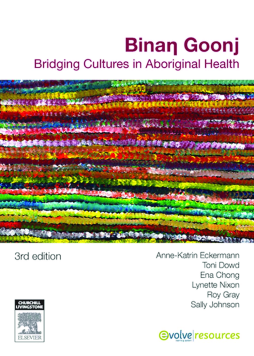
BOOK
Binan Goonj
Anne-Katrin Eckermann | Toni Dowd | Ena Chong | Lynette Nixon | Roy Gray | Sally Margaret Johnson
(2010)
Additional Information
Book Details
Abstract
A newly-updated edition of the definitive textbook on Aboriginal Health issues
Binan Goonj, 3rd Edition: Bridging cultures in Aboriginal health is a comprehensive Indigenous health text which addresses key topics in a clear and accessible manner.
Thoroughly updated and revised, the latest edition of Binan Goonj sheds light upon the many multidisciplinary topics within the complex field of Indigenous health.
With chapter titles including Empowerment in Aboriginal Health and Aboriginal Communities Today, this authoritative health resource has been widely adopted as a teaching text across Australia.
Despite years of research, policy changes and interventions, it is widely documented that the health status of many Aboriginal people remains the poorest in Australia.
Binan Goonj, 3rd Edition: Bridging cultures in Aboriginal health explores the processes and practices underlying this situation, while providing practical strategies to work towards redressing it.
This latest edition will engage a diverse readership and challenge students and health professionals alike to examine their own values and the use of power in Australian society.
Elsevier’s Evolve website provides extensive support material for nursing and health professions faculty and students, including: • discussion questions • suggested reading on Aboriginal health and related topics • web links • an instructor’s manual featuring course delivery tips including topics such as adult learning, attitudinal change, colonisation, government policies, Indigenous media sites and cross-cultural education resources • video links specific to chapters in this latest edition of Binan Goonj
• completely updated to reflect major Indigenous health policy changes since the second edition• an in-depth exploration of the collaboration between Aboriginal and non-Aboriginal people
• the use of Aboriginal health case studies and critical incidences to bring academic discussion and analysis to life
• processes that have been successfully incorporated into 18 years of cross-cultural workshops
Table of Contents
| Section Title | Page | Action | Price |
|---|---|---|---|
| Front Cover\r | Cover | ||
| Binaη Goonj\r | iii | ||
| Binaη Goonj:Bridging Cultures in Aboriginal Health | v | ||
| Copyright\r | vi | ||
| Contents | vii | ||
| Introduction | ix | ||
| About the authors | xii | ||
| Acknowledgements | xv | ||
| CHAPTER 1\rBackground to\rAboriginal/non-Aboriginal interactions in Australia | 1 | ||
| PART A: COLONISATION IN AUSTRALIA | 1 | ||
| Introduction | 1 | ||
| What is culture? | 2 | ||
| Adaptation | 3 | ||
| Terra nullius | 5 | ||
| Cultural relativism | 6 | ||
| Principles underlying colonisation in Australia | 7 | ||
| The process of colonisation | 13 | ||
| PART B: GOVERNMENT POLICIES | 21 | ||
| Protection/segregation (1890s–1950s) | 21 | ||
| Assimilation within protection | 25 | ||
| Assimilation (1951–65) | 27 | ||
| A change to self-determination orself-management? (1972–1988) | 28 | ||
| Reconciliation or economic rationalism? (1996–2007) | 30 | ||
| A new beginning? 2008 and beyond | 32 | ||
| The aftermath of government policies: imposed identity | 34 | ||
| Aboriginal remembrances of fringe settlement life | 37 | ||
| CHAPTER 2\rAboriginal communities today | 43 | ||
| Introduction | 43 | ||
| PART A: STRATIFICATION IN AUSTRALIA | 44 | ||
| PART B: THE CYCLE OF POVERTY | 47 | ||
| Employment | 49 | ||
| Housing | 57 | ||
| Education | 59 | ||
| Health | 62 | ||
| Breaking the cycle? | 65 | ||
| CHAPTER 3\rCoping with\rchange and violence | 73 | ||
| Introduction | 73 | ||
| PART A: SYSTEMIC BIAS AND STRUCTURAL VIOLENCE | 73 | ||
| Systemic frustration and Aboriginal politics | 75 | ||
| PART B: PROCESSES OF SOCIO-CULTURAL CHANGE | 79 | ||
| PART C: TRAUMATIC EFFECTS OF RAPID CHANGE | 82 | ||
| Stress and anxiety | 83 | ||
| Substance abuse | 85 | ||
| Family violence | 87 | ||
| Suicide | 93 | ||
| CHAPTER 4\rCultural vitality | 98 | ||
| Introduction | 98 | ||
| PART A: ABORIGINAL COMMUNITIESAND CULTURAL VITALITY | 99 | ||
| PART B: EXAMPLES OF CULTURAL VITALITY | 101 | ||
| Family organisation | 101 | ||
| Patterns of reciprocity | 102 | ||
| Patterns of decision making | 104 | ||
| Spirituality and identity | 108 | ||
| Cultural vitality, identity and land | 110 | ||
| National land rights and Mabo | 114 | ||
| CHAPTER 5\rCulture shock | 121 | ||
| Introduction | 121 | ||
| Culture shock | 122 | ||
| Communication | 128 | ||
| Mechanical differences | 137 | ||
| Isolation | 138 | ||
| Customs | 142 | ||
| Attitudes and beliefs | 143 | ||
| Culture shock: hospitalisation | 144 | ||
| Managing culture shock | 153 | ||
| Working in partnership | 158 | ||
| CHAPTER 6\rPeople Centred Care | 161 | ||
| Introduction | 161 | ||
| Health | 163 | ||
| Determinants of health | 168 | ||
| Primary Health Care | 170 | ||
| Cultural safety | 183 | ||
| CHAPTER 7\rEmpowerment\rin Aboriginal health | 196 | ||
| Introduction | 196 | ||
| PART A: EMPOWERMENT | 196 | ||
| PART B: AN EXAMPLE OF EMPOWERMENT: ABORIGINAL COMMUNITY-CONTROLLED HEALTH SERVICES | 199 | ||
| PART C: FACTORS THAT INHIBIT EMPOWERMENT | 202 | ||
| PART D: CASE STUDIES IN EMPOWERMENT | 212 | ||
| References | 219 | ||
| Index | 235 |
